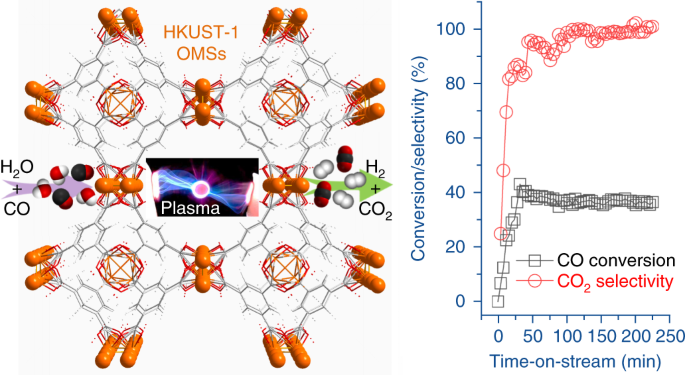
Authors (11): N. Al-Janabi, S. Chansai, X. Fan, A. Goguet, C. Hardacre, B. Inceesungvorn, P. A. Martin, C. E. Stere, S. F. R. Taylor, K. Wangkawong, S. Xu
Themes: Energy DOI: 10.1038/s41929-018-0206-2
Citations: 189
Pub type: article-journal
Pub year: 2019
Publisher: Springer Nature
Issue: 2
License: http://www.springer.com/tdm
Publication date(s): 2019/02 (print) 2019/01/14 (online)
Pages: 142-148
Volume: 2 Issue: 2
Journal: Nature Catalysis
Link: http://www.nature.com/articles/s41929-018-0206-2
URL: http://dx.doi.org/10.1038/s41929-018-0206-2The limited thermal and water stability of metal–organic frameworks (MOFs) often restricts their applications in conventional catalysis that involve thermal treatment and/or use of water. Non-thermal plasma (NTP) is a promising technique that can overcome barriers in conventional catalysis. Here we report an example of an NTP-activated water–gas shift reaction (WGSR) over a MOF (HKUST-1). Significantly, the exceptional stability of HKUST-1 was sustained under NTP activation and in the presence of water, which led to a high specific rate of 8.8 h−1. We found that NTP-induced water dissociation has a twofold promotion effect in WGSR, as it facilitates WGSR by supplying OH and sustains the stability and hence activity of HKUST-1. In situ characterization of HKUST-1 revealed the critical role of open Cu sites in the binding of substrate molecules. This study paves the way to utilize MOFs for a wider range of catalysis. MOFs have found limited application in catalysis so far, as the result of their limited thermal and hydrolytic stability. Now, non-thermal plasma is shown to be able to promote and sustain the activity of HKUST-1 and other MOFs towards the water–gas shift reaction despite the presence of water. [In a previous version of the graphical abstract, CO conversion was incorrectly labelled CO2 conversion.]
| Name | Description | Publised |
|---|---|---|
| 41929_2018_206_MOESM1_ESM.pdf | Supl. data for Sustaining metal–organic frameworks for water–gas shift c... | 2019 |
<< Previous Back Next >>